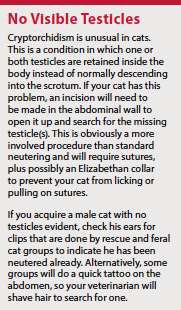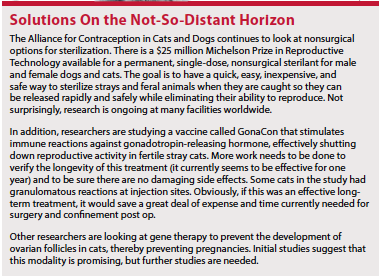Most pet cats are spayed or neutered. Dealing with pungent male urine sprayed to mark territory or the histrionics of a female cat in heat quickly lead to the need for a permanent resolution through surgery (unless you are a cat breeder, of course). But there are a few other things to know.
What Does a Neuter Entail?
For many male dogs, a vasectomy might be the right choice instead of castration, which removes the testicles. By keeping his testicles, the dog has the physical benefits of his hormones (especially important if he’s a sporting dog), but he would not be able to help overpopulate the canine world. Of course, he’ll still try.
In cats, doing a vasectomy obviously would help feline overpopulation as well, but this procedure would not stop the behaviors that drive owners crazy. A vasectomized cat still sprays and still goes out and fights.
Therefore, most cat neuters involve removing both testicles. This is done under anesthesia with one or two small incisions in the scrotum. The testicles are removed, and the vessels are tied to prevent any bleeding. Generally, the incision sites are left open to heal. This is a routine operation done at virtually every veterinary clinic with minimal risk.
Chemical castration using a drug like Zeuterin has been approved for dogs, but it is not an option for cats at this time.
What Does a Spay Entail?
A traditional spay surgery is a complete ovariohysterectomy (OVH), which is the removal of both ovaries and the uterus. This entails an incision in the abdomen under general anesthesia and removal of the organs with sutures or staples to prevent bleeding internally and then in the skin to close the incision. Many cats will need an Elizabethan collar to prevent licking at the incision or pulling at sutures or staples.
 For female dogs, some owners opt for things like ovary or uterine sparing operations, trying to maintain at least some hormones. There have been studies showing a possible increase in some orthopedic problems and cancers in certain breeds if spayed (or neutered in some cases), hence considering leaving one or both sets of reproductive organs. Research investigating these issues in cats is currently lacking.
For female dogs, some owners opt for things like ovary or uterine sparing operations, trying to maintain at least some hormones. There have been studies showing a possible increase in some orthopedic problems and cancers in certain breeds if spayed (or neutered in some cases), hence considering leaving one or both sets of reproductive organs. Research investigating these issues in cats is currently lacking.
Some veterinarians are lobbying for uterus-sparing surgery in cats. This would mean some hormonal influences would remain, but your cat would not experience heat cycles and could not become pregnant.
The risk of pyometra (a uterine infection related to heat cycles) is low without ovarian influence. Leaving the ovaries intact would mean heat cycles would continue, which might eliminate the cancer-preventing benefits of a complete OVH.
“I do not recommend ovary-sparing surgery because the cat will still come into heat, exhibit the same undesirable behaviors as an intact female, and be predisposed to health conditions such as mammary cancer, which, by the way, is the third most common cancer in cats of which up to 96% of mammary tumors in cats are malignant. I also don’t recommend uterine-sparing surgery because there is always a risk the cat could develop cancer or other diseases of the uterus,” says Leni Kaplan DVM, senior lecturer, Cornell University’s College of Veterinary Medicine.
Once again, if your stray female is not showing signs of heat, look for an ear clip or tattoo signifying that she was spayed while feral. A small surgical scar may also be evident if her abdomen is shaved.
Ideal Age
Determining the ideal age to spay or neuter your cat isn’t as simple as it may seem. Traditionally, spaying/neutering has been performed at 6 months of age, but this has more recently changed. Many female cats will have their first heat at 5 or even 4 months of age. The American Association of Feline Practitioners now says that 4 to 5 months is a fine, perhaps even ideal, age for spay/neuter timing.
The Association of Shelter Veterinarians (ASV) suggests an even earlier spay/neuter age, particularly for kittens in a shelter or rescue situation. This organization supports spay/neuter for kittens from 6 to 18 weeks of age. It recommends screening the kittens so that only healthy kittens have surgery at this young age but suggests that surgery and anesthesia times are shorter and recovery is faster when this procedure is carried out at this early age. For kittens in a permanent home, ASV suggests surgery at 18 weeks of age or older might be preferable due to the development of immunity through vaccinations, as these kittens would be finished with their initial vaccine series.
Spaying your cat before her first heat virtually eliminates the risk of mammary cancer. This is a serious concern, since most breast cancers in cats are aggressive and malignant. With removal of the uterus and ovaries, the risk of cancer in those organs is eliminated, as is the possibility of uterine infections (pyometra). A spayed cat won’t get pregnant and risk dystocia (a difficult labor) or contribute to the feline overpopulation problem.
A neutered male is much less likely to spray or mark his territory and is less likely to roam or get into fights.
Spayed and neutered cats seem to have improved longevity when compared with their intact counterparts. A 2013 Banfield State of Pet Health Report on life expectancy in cats showed that for spayed females, life expectancy was 13.1 years and for intact females, 9.5 years. Life expectancy for neutered males was 11.8 years and for intact males, 7.5 years. This differential may be partly due to the fact that spayed and neutered cats are more likely to be indoor house pets, so are at reduced risk of being hit by a car and infectious diseases that are often rampant in outdoor cat populations.
Concerns About Early Spay/Neuter
Initially, there were concerns related to the surgeries themselves with early spay/ neuter. More recently, anesthetic protocols have been refined for kittens that weigh at least 2 lbs. They do need to be carefully watched for hypothermia and/or hypoglycemia, but planning warming stations and only withholding food for two hours prior to surgery seem to counter those problems in most cases. Many veterinarians feel that the actual surgery is safer and faster, as the organs are less developed.
Beyond the surgeries themselves, effects on urinary tract problems, behavior, and orthopedic problems were considered. Studies have shown no increase in urinary blockage in male cats who were neutered very early on. Ureteral diameter is not influenced. Behavior problems were also evaluated and shown not to be affected by the early surgeries. A study of 800 shelter kittens showed no increase in undesirable behaviors in those that had undergone early spay/neuter.
Orthopedic problems have shown up in some dog breeds with early spay/neuter, especially medium to large or giant breed dogs. Cats tend to have fewer orthopedic defects to begin with, and studies have not shown an increase in problems with early spay/neuter. Cats that undergo early spay/neuter may experience some bodily changes, such as being taller and longer in body shape, due to a later closure of bone growth plates. Overweight young male cats that undergo early neuter may be slightly more at risk for a “slipped” femoral head requiring surgery.
Obesity is a problem seen in many pet cats, no matter the age at which they were spayed or neutered. Your veterinarian can advise you on the best nutritional plan for your kitten or cat to help prevent obesity and to regain a healthy weight for your cat if he/she becomes overweight. Regular exercise is as important as cutting calories for most cats in such weight loss programs.
What to Do?
Considering a kitten in a secure, permanent home is different than considering a population of shelter kittens. Pet cats are generally kept indoors and aren’t roaming and potentially contributing to the feline overpopulation problem. So, you may choose to wait until 5 or 6 months of age so your kitten is past her initial vaccinations.
On the other hand, if your male kitten is even thinking of starting to spray his urine to mark his territory, you will want that stopped. If your female kitten goes into heat, you will probably want that behavior halted as well. Spaying/neutering your kittens at 5 months old, theoretically before puberty hits, should prevent those situations.
The Feline Fix by Five campaign is endorsed by the American Veterinary Medical Association, American Association of Feline Practitioners, Association of Shelter Veterinarians, American Animal Hospital Association, EveryCat Health Foundation (formerly the Winn Foundation), Catalyst Council, Cat Fanciers’ Association, and The International Cat Association.
Dr. Kaplan believes that the benefits of early spaying/neutering (8 weeks and 5 months of age for shelter and owned cats, respectively) are backed by research (evidence-based medicine). Early spay/neuter promotes longevity, is easier, faster, and safer from an anesthesia and surgery standpoint, helps decrease overpopulation, and poses few, if any, medical or behavioral risks.

Kittens are adorable.
Cherry-Merry | iStock
As always, this is a decision for you and your veterinarian to make together, putting the best interest of your new kitten first.





